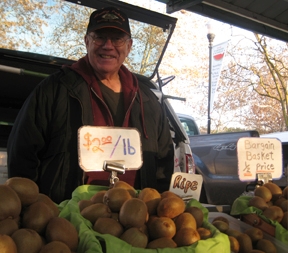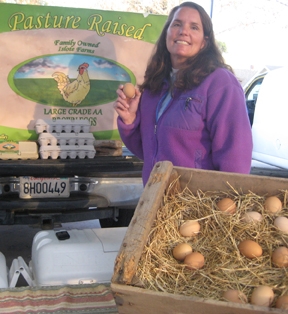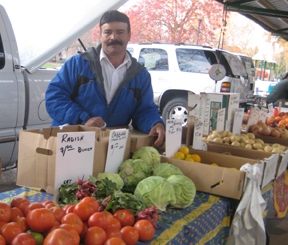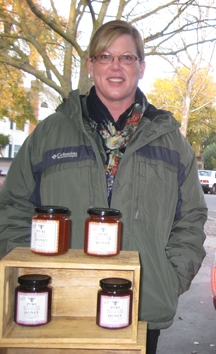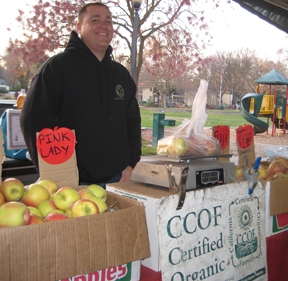Posts Tagged: eggs
December farm stories
Davis Wednesday afternoon farmers' market can be quiet in December, so what better time to learn a little about what's going on back at the farms? Every farmer I talked with today had delicious treats to sell and a story to tell. Here are a few:
Did you know that Gridley is the kiwi capital of America? There used to be a kiwi festival and a kiwi queen, but that all got too expensive for Gridley's kiwi farmers quite a few years ago, Frank Stenzel reports. He's getting ready to start pruning his 14 acres of kiwi vines next week; pruning will take a crew of 12 about two weeks. After pruning, each of the 25 or 30 canes on each kiwi vine will need to be tied to a trellis, very much like grape vines, to be ready for next year's growth.
The fuzzy green fruit for sale today from Stenzel's Kiwi Farm was harvested late in October and has been held in cold storage at 32 degrees since then. The fruit will last about six months stored this way, allowing Stenzel to bring out what he needs, grade it by size, let it ripen a little, but sell it while it's still firm. When you bring your kiwis home, let them ripen three or four days more for the best flavor.
Now that the weather is getting colder, the older chickens at Annette Jones' Islote Farms in Esparto have started molting. For a few weeks, they will lose feathers and stop laying eggs. But Jones isn't worried; in fact, she planned for this. Younger hens are picking up the slack because they hatched later in springtime and are just starting to lay eggs in December and January. The older hens can take their much needed break while the youngsters get busy. The fresh eggs from the younger hens are available at the market today in small and medium sizes. When springtime comes, all the birds will be laying again and eggs will be plentiful.
On Federico Toledo's Toledo Farm in Lodi, his son, brother, brother-in-law and other family members are busy planting this month - cabbages, broccoli, cauliflower, spinach, beets, cilantro, carrots, onions and curly parsley. What they're planting now will be at the farmers markets in March, April and May, if the weather cooperates. The 20 long rows of onions going in now will yield green onions in February and March, full-size fresh onions in April and May, and then dry onions in June and July. Today's market table has stories too: The last red tomatoes of the year are for sale today; they were picked green in November and ripened with a heater. The winter squash was actually grown in summer and harvested in August - it gets sweeter over the months and keeps well in winter. The persimmons, grapefruit, lemons and apples were all fresh-picked by the farm family.
All the rice has been harvested now at Robin Harlan's Bullfrog Farms in Winters, and the 3,000 hives of Bullfrog Bees are getting pollen patties to make it through the winter since there aren't enough blossoms to keep them fed without help this time of year. There's time now for bottling the honey; it's been stored in big stainless steel barrels since the Harlans harvested it in the summer. Bullfrog Farms grows more than 200 acres of almond trees which start blooming in January, so the bees will have blossoms very soon to pollinate and pollen to gather for more honey. After working in the Bullfrog orchards, they'll go to Blue Diamond almond orchards, and then to orange groves in Winters. Local honey is the sweet result of these hard-working bees.
Todd Evans works at certified organic Mount Moriah Farms in Clements. Today he's selling crisp Fuji and Pink Lady apples. Up until two days ago, Evans, farm owner Steve Smit, and a couple of other guys were harvesting apples. Now they're getting ready to prune all the trees, which will take the four of them about a month. The apples should last in storage until about May, just long enough for the cherries to be ready.
Give it a try - visit your local winter farmers market and learn some new stories!
To find farmers' markets in your community, visit the UC small farm program's California Agriculture Tourism Directory.
The party's ova
Spring is a big time of year for celebrating with a very cheap (cheep?), common, protein-rich food: the chicken egg. And because the hard-boiled egg has a special place at the Seder table and an important role in Easter morning hunts and afternoon picnics, eggs right now are selling like hotcakes. Problem is, the more eggs your market sells, the more likely you are to get them extra fresh, and consequently, the more trouble you're likely to have getting the things to peel when it's time to eat them up.
Chemistry is at the root of the egg-peeling problem: a newly laid egg has a slightly lower, more acidic pH value than the raw egg that you've stored in the refrigerator for a few days. The higher pH of the stored egg allows its white to cling less firmly to the membrane just inside the shell once it is cooked, and less cling means you can get the shell off more cleanly and easily. If you managed to plan ahead and get your eggs five or more days ahead of time this year, good for you! If you didn't, well, better luck next time. Clean-peeling or not, they'll still taste great.
There's a whole lot more to know about eggs than you might imagine—like whether you should wash eggs before you put them in the fridge (you shouldn't), what's the best way to store eggs in the fridge if you want them to last (pointy end down), and whether the refrigerator door egg rack was really such a great invention after all (it wasn't)—and a fun way to learn more is to visit a 4-H Avian Bowl competition at your local County Fair or other 4-H event.
Thanks to the guidance and commitment of UC Extension Poultry Specialist Francine Bradley, California 4-H teams have been doing very well lately in the Avian Bowl, winning first place in the national competition in eight out of the last ten years.
So next time you have a question about eggs or chickens, go find a 4-Her. Just don't ask them which came first. They get that a lot.
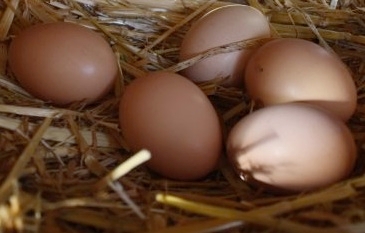
brown eggs in the straw
Californians should be careful with eggs
When Bill Clinton was president in the 1990s, his Council on Food Safety identified eggs as a food that poses a risk to children, the elderly and people with compromised immune systems. The Clinton administration launched a safety plan that aimed to eliminate Salmonella contamination in eggs entirely by 2010.
Unfortunately, the goal was not met. This month, a vast outbreak of Salmonella food poisoning prompted the recall of half a billion eggs produced in Iowa. In California, UC Cooperative Extension worked with other agencies and the egg industry to create the California Egg Quality Assurance Program, which is implemented voluntarily by 95 percent of the state’s egg producers. California-produced eggs have been free of Salmonella for the past 10 years.
However, not all eggs sold in California are produced in the state. In fact, the FDA announced this week that Trafficanda Egg Ranch of Van Nuys distributed eggs affected by the recall to grocery stores and foodservice companies in California.
That fact underscores the importance of using basic egg safety measures now and whenever Californians consume eggs, according to UC Cooperative Extension nutrition, family and consumer sciences advisor Cathi Lamp.
“Americans consume an average of 234 eggs per person per year,” Lamp said. “Since infected eggs still make it from the farm to the table, we have more work to do.”
People with health problems, the very young, the elderly and pregnant women (and the unborn child) are particularly vulnerable to Salmonella infections and should be extra careful with eggs, but everyone is advised to take precautions to minimize the risk of being exposed to Salmonella bacteria.
Lamp suggests the following precautions:
- Modify recipes for foods that were traditionally eaten with raw eggs, including smoothies, Caesar salad dressing, Hollandaise sauce, cookie dough, mayonnaise, ice cream and egg nog. If consumers wish to eat foods with "raw" eggs, prepare them with a pasteurized egg product like Egg Beaters.
- At the store, choose grade A or AA eggs with clean, uncracked shells.
- Make sure the home refrigerator is running at 40°F. Store eggs in the coldest part of the refrigerator, not in the door. Don’t wash eggs, as they have a protective coating applied at the packing plant.
- Use raw eggs within three to five weeks. Hard-cooked eggs will keep for one week. Refrigerate leftover cooked egg dishes and use within three to four days.
- Cook eggs until both the yolk and the white are firm. Scrambled eggs should not be runny.
- Casseroles and other dishes containing eggs should be cooked to 160°F (72°C). Use a food thermometer to be sure.
- Wash hands, utensils, equipment and work areas with hot, soapy water before and after contact with eggs and egg-rich foods.
- Avoid keeping eggs or foods containing eggs out of the refrigerator more than 2 hours.

Egg safety can prevent a foodborne illness.
Chickens, chickens everywhere
The surge in popularity of home chicken-raising is astounding. From cities to farms, more and more people are keeping small numbers of chickens for egg production, as family pets, and sometimes for meat production. The city of Davis, Calif. even had a “Tour de Cluck” recently – a bicycle tour of 25 home chicken coops in Davis (the tour sold all 500 tickets and served as a local educational fundraiser).
The amount of attention and care that families spend on their chickens shows that chickens are a labor of love, much as any family pet. Every hen I visited on the Tour de Cluck had a name, and each owner assured me that their “girls” all have their own personalities. Some of the chicken coops were woodworking pieces of art.
Chicken stories are showing up in all types of mainstream media. Feature articles have appeared recently in The New Yorker (Susan Orlean’s home chickens), the New York Times (why Americans raise chickens; women in Berkeley who raise chickens); and a book review of raising chickens in the city), and in the CA&ES Outlook alumni magazine where I work at UC Davis – the College of Agricultural and Environmental Sciences (backyard chicken farming, page 10).
Chickens aren’t difficult to manage, but like raising any animal, the prospective chicken owner should know what he or she is taking on, and should be a responsible animal owner. While it may be fun to muse over the fancy breeds, or to salivate over the thought of fresh omelets each day, it’s important to learn about housing, nutrition, health, local ordinances (which may limit the number of hens and/or the ability to keep roosters), and other pertinent topics.
Where to get information?
- Bookstore shelves are awash with chicken-raising books. Check your local bookstore or online book source. There are even chicken-raising books in the “idiot’s” and “dummies” series (The Complete Idiot’s Guide to Raising Chickens; Raising Chickens for Dummies; and Building Chicken Coops for Dummies).
- Sunset magazine has a useful list of books on raising chickens
- Sunset magazine also has a free download on how to raise chickens
- Backyard Poultry is a popular bimonthly magazine with special topics each month (breeds, health, nutrition, etc.).
- Your local Cooperative Extension or 4-H office should be able to match you up with chicken-raising resources. Here are two University of California sites with information on raising chickens: UC Davis Poultry Page, and ANR publications.
Whatever your reason for raising chickens — and the reasons are many — do your homework first and make sure you get the proper supplies and the breeds that will give you years of pleasure . . . and fresh eggs.


